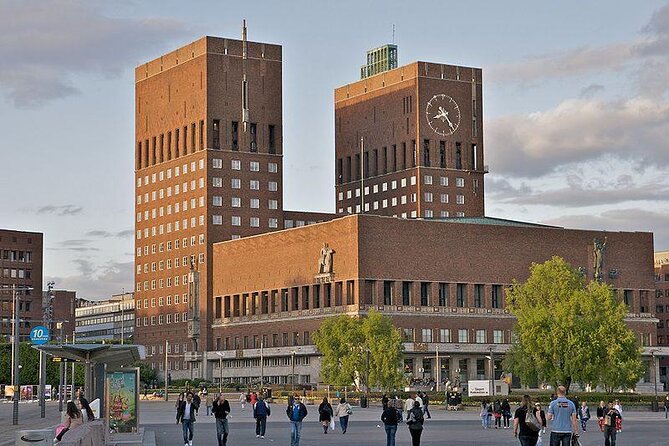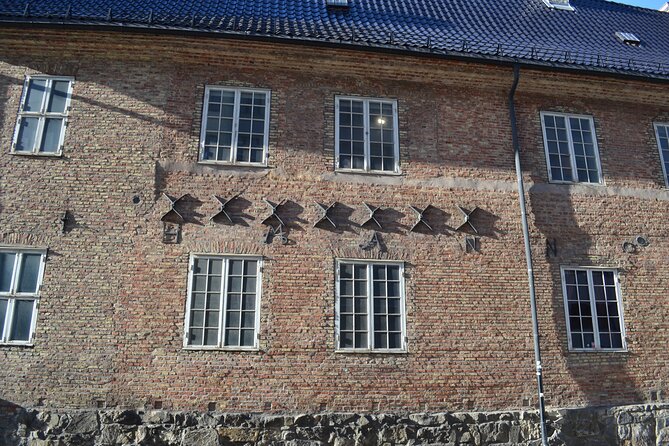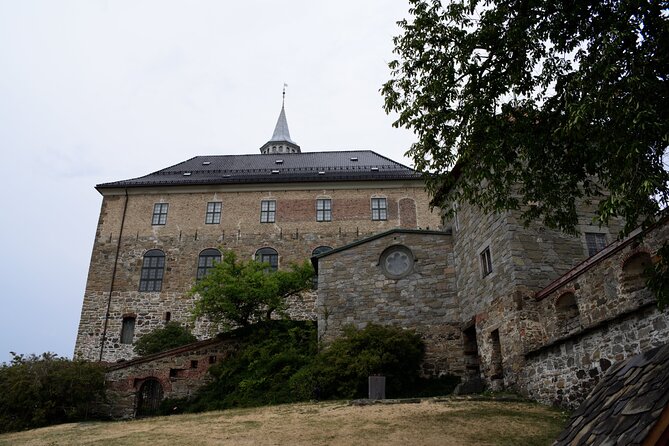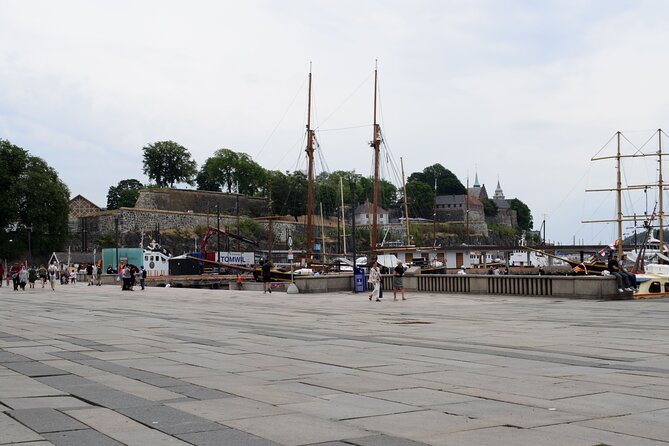Exploring Oslo’s journey through time unveils a captivating narrative of resilience and reinvention. From its humble Viking beginnings to the intricate medieval tapestry woven at Akershus Fortress, Oslo’s story is one of constant transformation. Amidst the echoes of its past, the city has embraced change, emerging as a modern-day gem that seamlessly blends tradition with innovation. As the layers of history unfold, one can’t help but wonder about the untold tales that shaped Oslo into the vibrant city it is today.
Good To Know

- Oslo founded in 1048 by King Harald Hardrada, flourishing as a vital trading hub.
- Akershus Fortress built in the late 13th century, serving as a royal residence, stronghold, and prison.
- Danish and Swedish rule influenced governance, trade connections, and administrative changes.
- Industrial Revolution transformed Oslo with technological advancements and cultural renaissance.
- German occupation during World War II brought strict regulations, resistance, and eventual liberation in 1945.
Early Settlements and Viking Origins

Tracing back to its early settlements and Viking origins, Oslo’s history is deeply intertwined with the adventurous spirit of the Norse seafarers.
The city, nestled along the stunning fjords of Norway, was founded around 1048 by King Harald Hardrada. Originally known as ‘Ánslo,’ the area quickly became a vital trading hub for the Vikings due to its strategic location.
The Vikings, with their exceptional seafaring skills, explored far and wide, establishing trade routes and leaving a lasting impact on Oslo’s development. Their legacy can still be felt today in the city’s architecture, culture, and maritime traditions.
Visitors to Oslo can enjoy this rich history by exploring museums, archaeological sites, and even taking a boat tour to experience the city from the perspective of those intrepid Viking ancestors.
Interested in history? More Oslo historical sites we've covered
Medieval Oslo and the Akershus Fortress

Oslo’s journey through history continues into the medieval era, where the Akershus Fortress stands as a formidable symbol of the city’s past. Constructed in the late 13th century to protect Oslo from potential foreign invasions, the fortress has witnessed centuries of historical events.
It served as a royal residence, a military stronghold, and a prison during its long existence. The Akershus Fortress offers visitors a glimpse into Oslo’s medieval roots, with its well-preserved architecture and commanding presence overlooking the Oslo Fjord. Exploring the fortress allows one to step back in time and imagine the bustling life within its walls centuries ago.
As a testament to Oslo’s resilience and strategic importance, the Akershus Fortress remains a must-visit destination for history enthusiasts and curious travelers alike.
Union With Denmark and Sweden
During the period of union with Denmark and Sweden, Oslo experienced significant political shifts and cultural influences that shaped its identity for centuries to come. The city’s history during this time was marked by alternating periods of Danish and Swedish rule, impacting everything from governance to language and traditions. Under Danish influence, Oslo saw the hotel of trade connections and the construction of fortifications like Akershus Fortress. Swedish rule brought administrative changes and a shift towards more centralized government. This era of unions left a lasting imprint on Oslo, blending Nordic customs and creating a unique cultural tapestry that still resonates in the city today.
| Political Shifts | Cultural Influences | Key Developments |
|---|---|---|
| Danish and Swedish rule | Blending of Nordic customs | Construction of Akershus Fortress |
| Alternating governance | Language influences | Establishment of trade connections |
| Centralized government | Traditions evolution | Administrative changes |
Industrial Revolution and Modernization
Amidst the winds of change blowing through Europe, Oslo found itself at the crossroads of the Industrial Revolution, ushering in a new era of transformation and modernization.
The city embraced industrialization, leading to significant advancements in technology, transportation, and infrastructure. As factories sprung up and trade flourished, Oslo’s landscape evolved rapidly, with bustling ports and railways connecting the city to the rest of Europe.
The influx of new ideas and innovations during this period sparked a cultural renaissance, shaping Oslo into a vibrant hub of progress and development. The Industrial Revolution not only altered the city’s physical appearance but also laid the foundation for the modern metropolis that Oslo stands as today.
World War II and German Occupation

The dark clouds of World War II cast a shadow over Oslo, as the city faced the harrowing reality of German occupation. During this tumultuous period:
German forces invaded Oslo on April 9, 1940.
The Norwegian government evacuated, and King Haakon VII famously refused to surrender.
The occupying forces imposed strict regulations, affecting daily life.
Resistance movements, like the Milorg, bravely fought against the occupation.
Liberation finally came on May 8, 1945, marking the end of a challenging chapter in Oslo’s history.
The scars of war lingered, but Oslo’s spirit endured, ready to rebuild and move forward.
- Stand up Paddleboard Adventure in Leangbukta
- The Scenic Roadtrip, Oslo to Bergen via Flam & the Fjords
- Snowshoe Tour in Winter Wonderland – Oslo
- Round-Trip Private Transfer Oslo Airport OSL to Oslo City by Minibus
- Self-service Floating Sauna Experience – Public Session “Bragi”
- Private One-way Airport Transfer (Oslo Airport To/From Oslo)
Post-War Recovery and Prosperity

After enduring the hardships of German occupation during World War II, Oslo emerged resilient, embarking on a remarkable journey of post-war recovery and prosperity. The city quickly set out to rebuild its infrastructure, focusing on restoring damaged buildings and reviving its economy.
Through strategic planning and international partnerships, Oslo experienced a period of rapid growth and development. Industries flourished, and new opportunities arose, attracting a wave of investment and innovation. The resilience of its people and the determination to rebuild stronger than before played a vital role in Oslo’s resurgence.
As the city embraced modernization and progress, it transformed into a vibrant hub of culture, commerce, and opportunity, marking a significant chapter in its history of resilience and prosperity.
Contemporary Oslo and Cultural Diversity

In the bustling streets of Oslo today, a tapestry of cultures intertwines, showcasing the city’s vibrant contemporary landscape.
Here are some key aspects of contemporary Oslo and its cultural diversity:
Ethnic Enclaves: Neighborhoods like Grønland and Tøyen host a melting pot of nationalities, offering diverse culinary experiences.
Cultural Festivals: From the Oslo World Music Festival to the Mela Festival, Oslo celebrates a myriad of cultural traditions throughout the year.
International Cuisine: Savor world flavors in Oslo’s restaurants, reflecting the city’s multicultural population.
Artistic Expression: Galleries and street art exhibit a blend of global influences, capturing the city’s creative spirit.
Community Integration: Initiatives like language cafes and cultural exchanges foster understanding and unity among residents.
Sustainable Development and Future Outlook
Embracing eco-friendly practices and innovation, Oslo paves the way for sustainable development and a promising future outlook. The city has set ambitious goals to reduce carbon emissions, increase green spaces, and promote renewable energy sources.
Oslo’s focus on sustainable transportation is evident through its extensive network of electric buses, bicycles lanes, and pedestrian-friendly streets. By integrating nature into urban landscapes and implementing green initiatives like rooftop gardens and energy-efficient buildings, Oslo strives to create a healthier environment for its residents and visitors.
With ongoing efforts to combat climate change and prioritize environmental sustainability, Oslo is positioning itself as a global leader in green urban development, offering a glimpse into a future where cities harmoniously coexist with nature.
Frequently Asked Questions
What Are the Best Local Spots for Traditional Norwegian Cuisine in Oslo?
For a taste of traditional Norwegian cuisine in Oslo, locals recommend iconic spots like Kaffistova for classic dishes, Engebret Café for historical charm, and Lorry for a cozy atmosphere. Don’t miss these local favorites!
Can Visitors Participate in Any Traditional Norwegian Festivals or Events in Oslo?
Visitors can enjoy Oslo’s vibrant culture by participating in traditional Norwegian festivals and events. From food fairs to music celebrations, there are plenty of opportunities to experience the local customs and hospitality firsthand.
Are There Any Unique Shopping Experiences or Markets in Oslo Worth Exploring?
For visitors seeking unique shopping experiences in Oslo, exploring markets like Mathallen Food Hall and Grünerløkka’s vintage shops is a must. These vibrant spots offer a blend of local crafts, trendy goods, and delicious Nordic treats.
What Outdoor Activities or Natural Attractions Are Popular in Oslo for Tourists?
For travelers in Oslo, popular outdoor activities include hiking in Nordmarka, exploring the Vigeland Sculpture Park, and sailing on Oslofjord. These attractions offer a mix of nature and culture, making Oslo an ideal destination for outdoor enthusiasts.
How Can Visitors Engage With the Local Arts and Music Scene in Oslo?
To engage with Oslo’s local arts and music scene, visitors can attend concerts at venues like the Oslo Opera House and explore art galleries in neighborhoods such as Grünerløkka. Immerse in the vibrant culture!
The Sum Up
From its Viking roots to modern innovations, Oslo has embraced the challenges of history and emerged as a vibrant city that seamlessly blends its past with the present.
With a focus on sustainability and cultural diversity, Oslo continues to evolve and thrive, offering a unique experience for visitors and residents alike.
As the city looks towards the future, it remains a testament to resilience, creativity, and the enduring spirit of its people. Oslo truly is a city like no other.
More Historical Tours in Oslo
More Tour Reviews in Oslo
Looking for something different? Other Oslo activities we've written about
- Airport Transfer Oslo
- Kayak and Canoe Tour in Lake Bogstad
- Oslo All Inclusive Private Walking Tour
- 3days tour to Flåm-næroyfjord(or Preikstolen Hiking)-Bergen
- 13-day Norway tour with nature, art, and deep transformation
- Self Guided Tour in Oslo with 100 Captivating Audio Stories
- Railway walk along Old Drammen Line
- Off the beaten Path Private Tour at Ekeberg Park
- Private One-Way Airport Transfer from Oslo to Oslo Airport
- Akerselva River: Urban Paddling Adventure Kayak Tour
- Drøbak: Coastal Walk with Coffee, Buns, and Hammocks
- El-bike Rentals By The Oslo Tour
